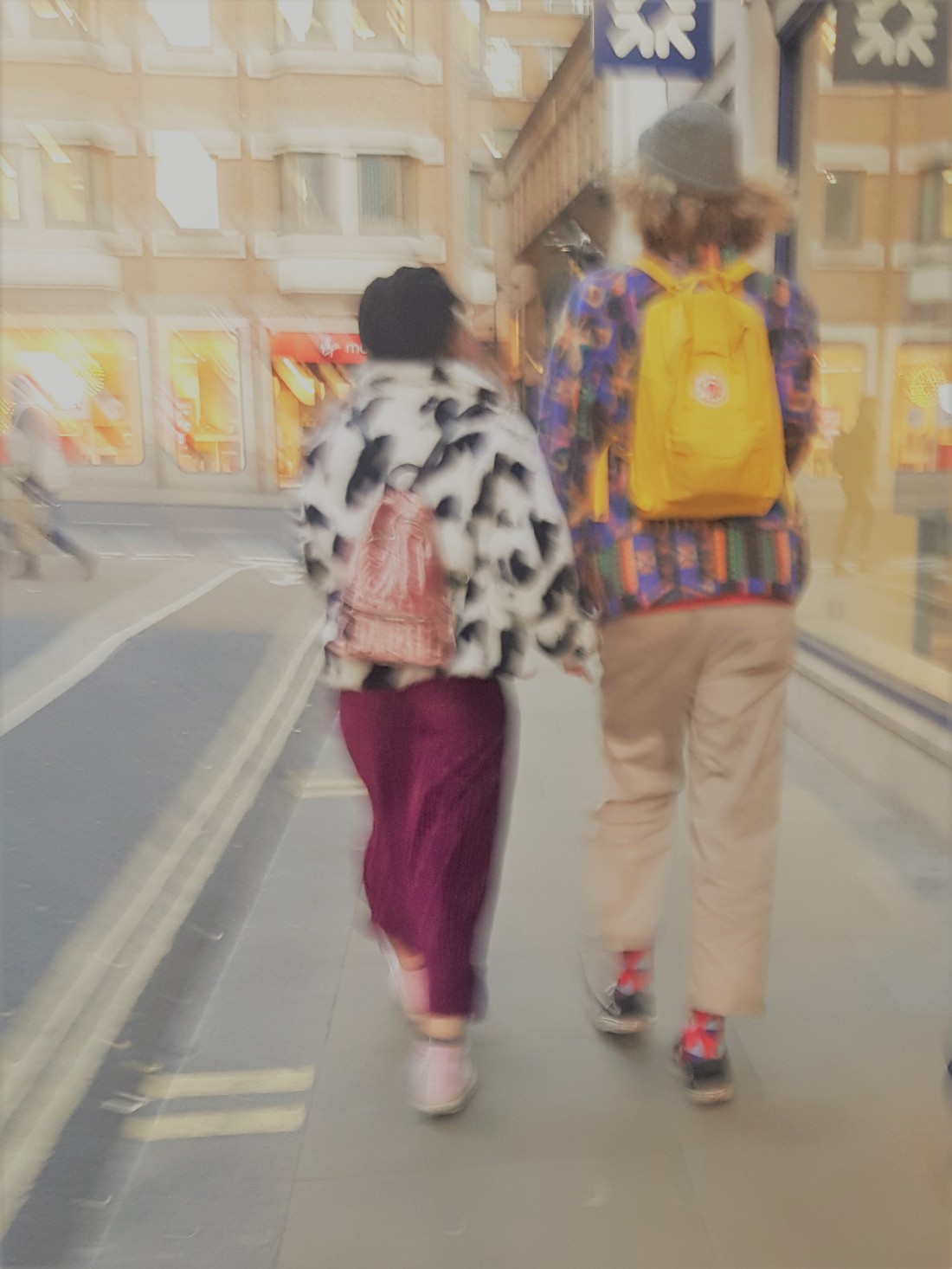

Illustrations, illustrations, everywhere, nor a person I can draw!
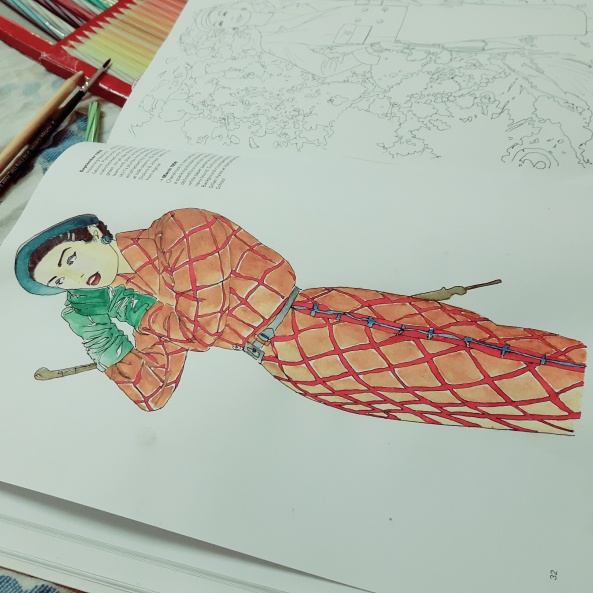
Illustrations are like everywhere! You click right, you go left, you look up or you scroll down, everything is filled with illustrative art of some sort. Is photography dead? or do illustrations make everything appear extra fashionable? But they do seem to be having a moment at the moment.
From live runway illustrations to illustration pop-ups, the art of figure drawing is being revived like never before. Going back into history, illustrations were merely one of the tools a fashion designer used to explain his vision of the garment to others. Towards the Sixteenth century, as the fascination with dressing up grew, fashion illustrations ( then popular as engraved plates) started becoming increasingly popular as a method of documenting fashion around the world. Journals began to be produced and the first fashion magazine called Le Mercure galant ( 1972) was published in France under the direction of Louis XIV.
Also since photography not yet existed as an option, illustrations of pretty looking women in corsets were used everywhere. Fashion illustration did die a tragic death once cameras came into being by the nineteenth century. The 1950s saw the fashion editors investing in photography and illustrations were used only for selected categories like lingerie and perfumes. It wasn’t until the 80s that fashion illustrations started bouncing back. And TADAAA! We are now open to a whole new universe of figurative fashion.
But from Charles Dana Gibson’s 19th century ‘Gibson Girl’ we have come a long way, learning to redefine beauty and perfection in the fashion that goes on the paper. From shapes to colours and materials to mediums, the new generation of illustrators is applying all the permutations and combinations possible to tell the story of a garment or a style with different emotions and also some humor.
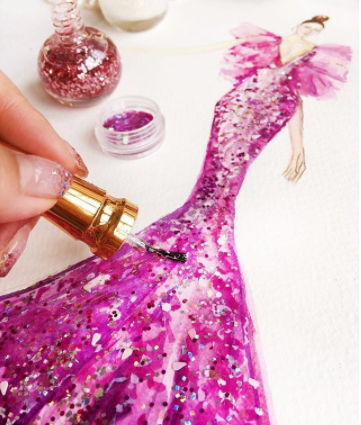
“Haute Couture is not only for runway, you can own it through your nail polish and brushes!” – Chan Clayrene.
This is how the Singapore based fashion illustrator introduces herself on her website called Artclaytion. The artist uses nail paints of all sorts to curate her version of a fashion figure. God bless Instagram, as the digital social media platform helped her develop an impressive client list which includes names like Chanel, Christian Louboutin, Harpers Bazaar, Clinique and many more.
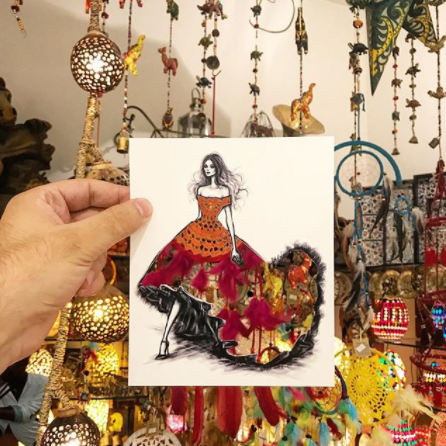
Visual artist-architect and illustrator Shamekh Bluwi is another creative soul in the era of new age fashion illustrations who is known for his clever digital and perceptual manipulation. Through his cut-out paper illustrations, he took fashion to the streets ( literally)! The series of illustrations were very well received and bought the Jordanian illustrator under the glory light.
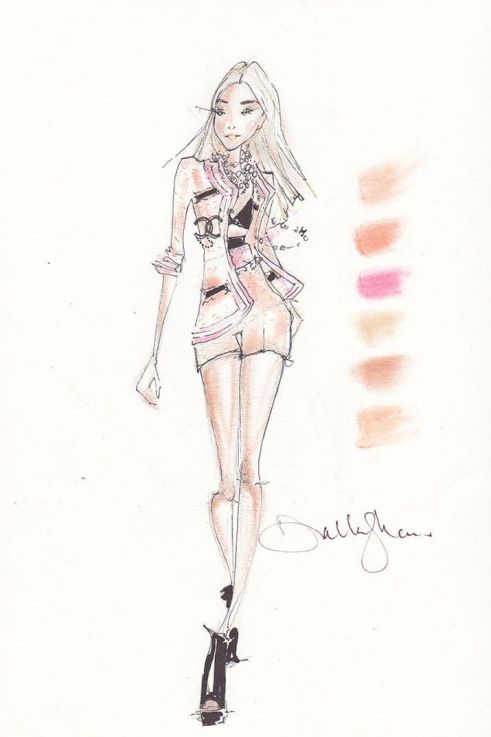
It obviously doesn’t end with these two fashion illustrators, but only begins. Many popular names in the industry like the ultimate Disney-girl Dallas Shaw are worth your time. She quit her full-time job to start her own fashion illustration business online and is today the woman whose multi-hyphenated personality inspires us all in a million ways. Her brilliantly visual career includes projects like the collaboration with Chanel to produce fashion illustrations using the brand’s classic tweed suit inspired eye-shadow palette.
Vikki Yau who works with Fashionary ( papery heaven for the true lovers of fashion illustrations) as an illustrator and marketing director in Hong Kong has her artwork published the company’s “Fashionpedia”. Touted as the ultimate fashion bible, the book is a visual dictionary of all things fashion. What is interesting is how the need for creative tools like Fashionary’s notebooks, sketchbooks, templates and the designer’s dictionary has evolved over time. And these kinds of exclusive merchandise establish the fact that fashion illustration has reinvented itself as a significant genre which everyone from fashion designers, fashion brands, artists and even people outside the creative industry value and have a genuine interest in.
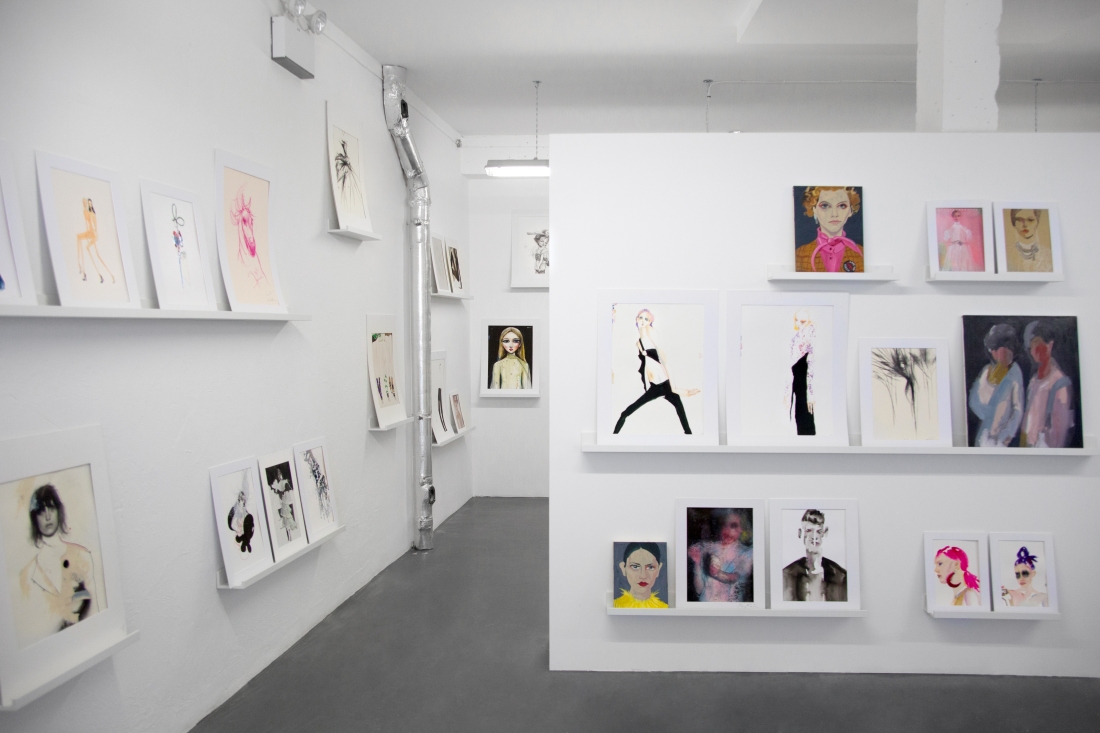
London-based SHOWstudio’s founder and director, Nick Knight who is well-known for his award-winning photography and fashion films recently unveiled his fashion illustrations pop-up at Floral Street in London. The gallery exhibits the studio’s collection of fashion illustrations commissioned by Knight from different artists. From established names like English artist Gill Button, Kelly Beeman and Blair Breitenstein to upcoming illustrators, the pop-up is one-of-its-kind opportunity to experience how fashion has been portrayed using the first kind of visual media which was pen and ink.
Knight, who was perhaps the first to stress on the importance of fashion films as a photographer, still believes in the power of illustrations. It is good to see that the industry has reached a point where fashion illustration and fashion photography are seen as two different and distinct disciplines. Hadn’t been the case then fashion illustration wouldn’t have blossomed so much as an independent industry.
“A drawn or collaged fashion image on the other hand can take us off guard and captivate the imagination through its style and make us linger a little longer before scrolling or swiping on the next thing. “
” The boundary between a photograph and otherwise ‘made’ image is increasingly blurred.”
The ” Journallustor’s” hyphenated profession is all about doing more of what makes her happy and drawing more than what meets the eye.
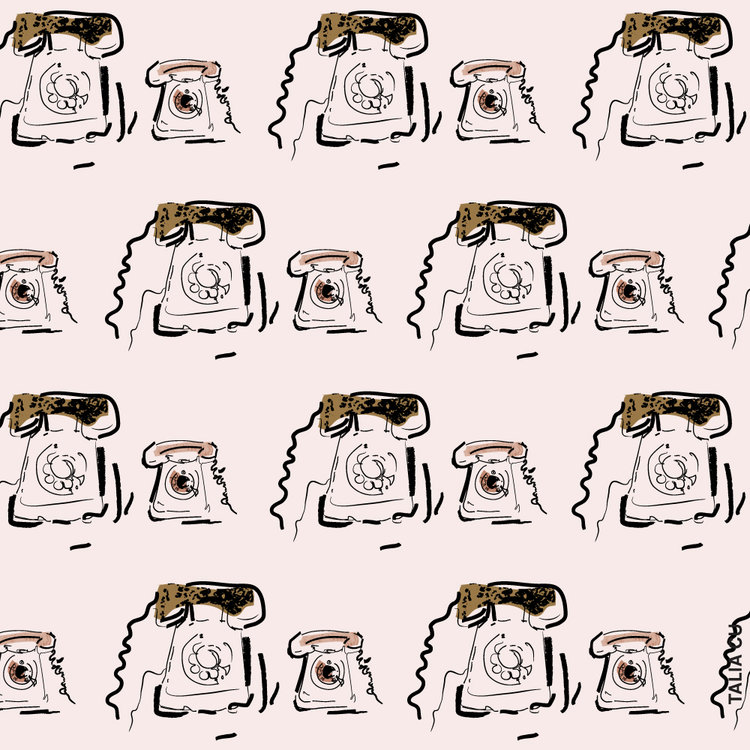
Sharpie-ing away her imagination in the form of some quirky art, Talía wants fashion to be known for its creative talent before anything else and her strokes stand for the very same. Proud of her Mexican roots, the Amsterdam based artist just wrapped up the first edition of her digital campaign about drawing Latin fashion. ” Everyone knows about the history and legacy of international fashion. Everyone knows about Manolo Blahnik. But when it comes to small and upcoming designers, there still exists a need to build stories around them.” says Talía who wants to write and draw more about them.
So has it become increasingly crucial to be able to communicate in more than one way? “This is a crazy time that we’re living in. It’s not only important to be present on different platforms, but the content should also be tailored and dynamic. It’s hard enough to get people’s attention as we are living a visual age in media, so we should take advantage of every form of content as much as we can” is what the illustrator-journalist has to say. Before taking up illustration as a career path, Talía was a full-time writer at Vogue Mexico, post completion of her fashion journalism studies in London. Now she is fully putting into practice her self-generated portmanteau ” Fashion Journallustrator” by playing the role of an illustrator who uses both words and images to tell a story.
“I think a huge advantage of illustrations is immediacy as you can instantly grab someone’s attention and tell your story without asking them to click on a link!” explains Talía on being asked what illustrations do that words cannot. She, however, does not want to give up on either of them. Because words allow us to explore a different side of the story and go deeper into the subject and bring out more details.
“The decision behind calling myself a fashion journallustrator also came from the fact that I loved creating illustrations, but I realized I didn’t want to be just an artist, I wanted something more dynamic that would allow me to keep on telling stories within fashion.”
Talking about the kind of stories she aims at telling; she wants to address issues like the commercialization of the fashion industry, which is leaving less and less room for creativity and experimentation. As a young journalist, she wants to be able to talk more about fresh talents who are often overshadowed by the more ‘influential’ and ‘sell-able’ of the lot. Not a big fan of catwalk shows, Talía is more drawn towards the natural expression of style which she finds in the people walking down the streets. She has a popular section on her web channel where she shares the illustrated version of ” Fashion that I found ( or that found me)” and also an arty avatar of the trends she spots on the streets in the St. Drawing section.
But did things just conspire to make her reach where she is? Not exactly, but maybe yes. ” I always used to draw as a kid!” tells Talía, but she never thought of doing anything with it as it came naturally to her. It was while she was working with Vogue Mexico, happily writing away stories that she thought of experimenting with the idea of a different way to convey the same message. That is when illustration happened. A lot of Skillshare classes and numerous self-learning lessons later, she developed her own unique style of illustrating fashion. Instagram helped of course. She happened to share her first illustration on the popular platform and the responses encouraged her to not stop. It was her interpretation of one of Simone Rocha’s designs.
Elaborating more on her creative process, she explains how all of her illustrations are majorly hand-drawn using thick or thine-line black markers and even charcoal in some cases. She then digitizes them on Illustrator a bit! The juxtaposition of dark lines of varying intensities with eclectic patterns lends a unique touch to her illustrations. Colours are something which amps up the entire mood of her artwork. ” Sometimes it’s just a certain colour that I see someone is wearing,and I won’t be able to get it out of my head.” adds Talía while explaining more about her sources of inspiration.
“I am particularly drawn to “regular” people’s sense of fashion. Walking around the city and watching the way people dress, how they combine colors, textures, patterns, that inspires me tremendously. “Real people” you could say!”
Speaking of her favorite illustrators which she feels makes up for a long list, she adds, ” I am fascinated by the energy of Donald Robertson’s drawings; the same for Christian Lacroix, I used to collect his stationary notebooks like crazy! I also adore Frida Wannerberger, perhaps because she’s the opposite of me, she’s meticulous and she creates the most interesting characters, I have two of her original drawings and they are my dearest treasure.” She is more drawn towards impressionists and is currently obsessing over Egon Schiele.
But would she love to progress into moving image and add a third dimension to her process of documentation of fashion? Yes, why not? animations for her can be an attractive way of telling stories to the audience and it is something she would love to learn more about. In fact, the project she had the most fun doing was about animations. It is called ” The contemporary Fashion Zine”, and she plans to bring back a revamped version back on her new web channel. “We’ll be waiting”, is all we can say. ca
https://www.instagram.com/p/6q2Xe3DAZT/embed/?autoplay=1
https://www.instagram.com/p/6q2Xe3DAZT/embed/?autoplay=1
Bizzare, the furball just fetched us something paw-some.
Doga? Hmm! Makes the long-dead Dick-Shun-ary twitch in the grave. Yoga for dogs or doga is perhaps the most contemporary twist ( of the brain perhaps!) to the ancient practice of yoga. But with the number of #dogyoga soring all over the internet, reports are quite right in predicting pet yoga to be among the hottest ( also the furriest) fitness trend in 2018.
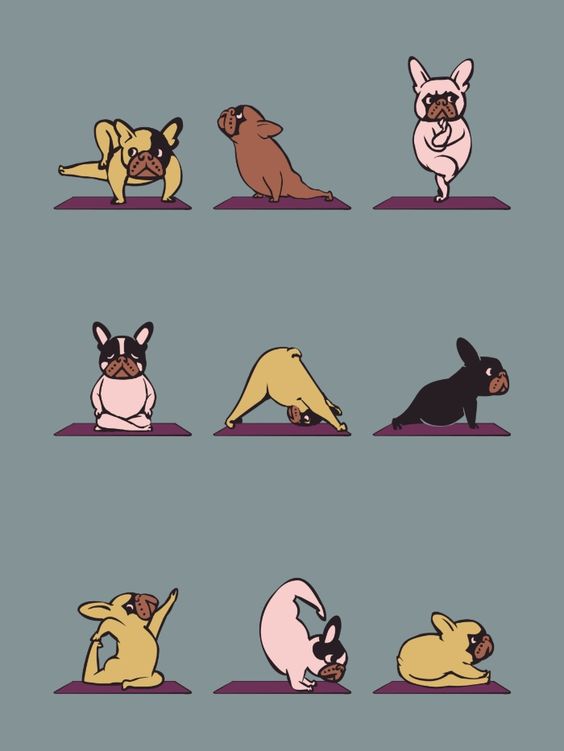
With doga classes being offered as a ” free” perk in rental apartments across New York and exclusive dog yoga parties ( Brooklyn hosted one) being hosted to get dog parents and their cuddly canines attain zen together, doga is indeed turning into a serious business.
“But once you understand it, you think: ‘This is so cool.'” Ms. Navarra told the NY Times on being asked about her experience. So might be too early to declare doga a funny fad and maybe some indulgence will bring in more clarity.
Namaste!
This new street style trend is slowly becoming hard to ignore.
While France was hosting “ First European Punk Rock Festival” in 1976, back in India, film producer and director Rajkumar Kohli was basking in the success of his horror fantasy thriller “Nagin”; inspired by French film The Bride Wore Black.
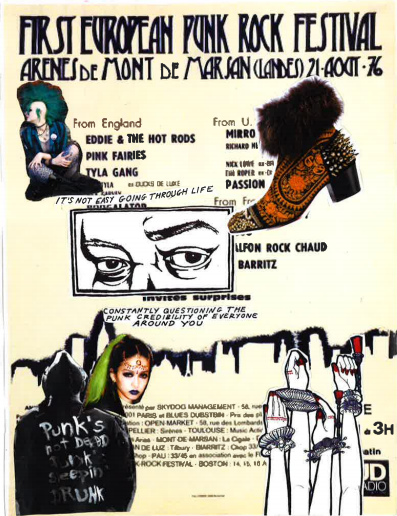
PUNK AS WE KNOW…
The punk subculture of the late 1970s that originated in America and later came to Britain, followed by other parts of the world, was much more than just a crazily hardcore genre of music. It meant different things to different people. Though it hugely influenced the fashion scene, it was much more than offensive tees, leather jackets, safety pins and outrageous body piercings. It came attached with a feeling of nostalgia and was more about the DIY approach towards self-expression. Youth-rebellion and a seamless mix of art and music with politics as the catalyst best sumps up the amorphous concept of ‘PUNK’. India for reasons aplenty, did not embrace the punk culture at that time. Maybe because the term ‘viral’ hadn’t gone viral till then.
FUSION FRENZY!
Interestingly though, from the late 70s and 80s onwards fusion became huge. Mixing of the east with the west was a big thing and not just with respect to music (The Beatles) but fashion (Let us Google Jean Paul Gaultier Spring RTW 1994) too. India’s punk rock music scene also started taking shape and also did the first generation of fashion designers come into being. By the 90s, MTV was launched in the country and BOOM; the youth was inspired and influenced by the offerings of the new TV channel. All was happy and merry in the land of sangeet and sarees.
FAST FORWARD
India didn’t fully jump all into the concept of punk and only a few music bands experimented with the genre and almost no one attempted walking down the street dressed like a 70s punk. However, the elements of the insanely popular subculture were and are still revived every now and then.
Latest experimentalists are the ‘Women of Today’ from India’s creative community of independent musicians, bloggers, photographers, and influencers.
BOLLY-HOOD?
Popular Indian-origin Grammy nominated artist Raja Kumari’s personal style blends in the punk rock elements well with those quite desi. It is quite a mirror reflection of the music she creates.
Earliest adaptors of the Indian-Punk trend might be signers like Tritha Sinha and Sona Mahapatra who gave Indo-Western dressing their own musical twist by introducing elements like big dark bindis, kohl and quirky drapes with a pop of color.
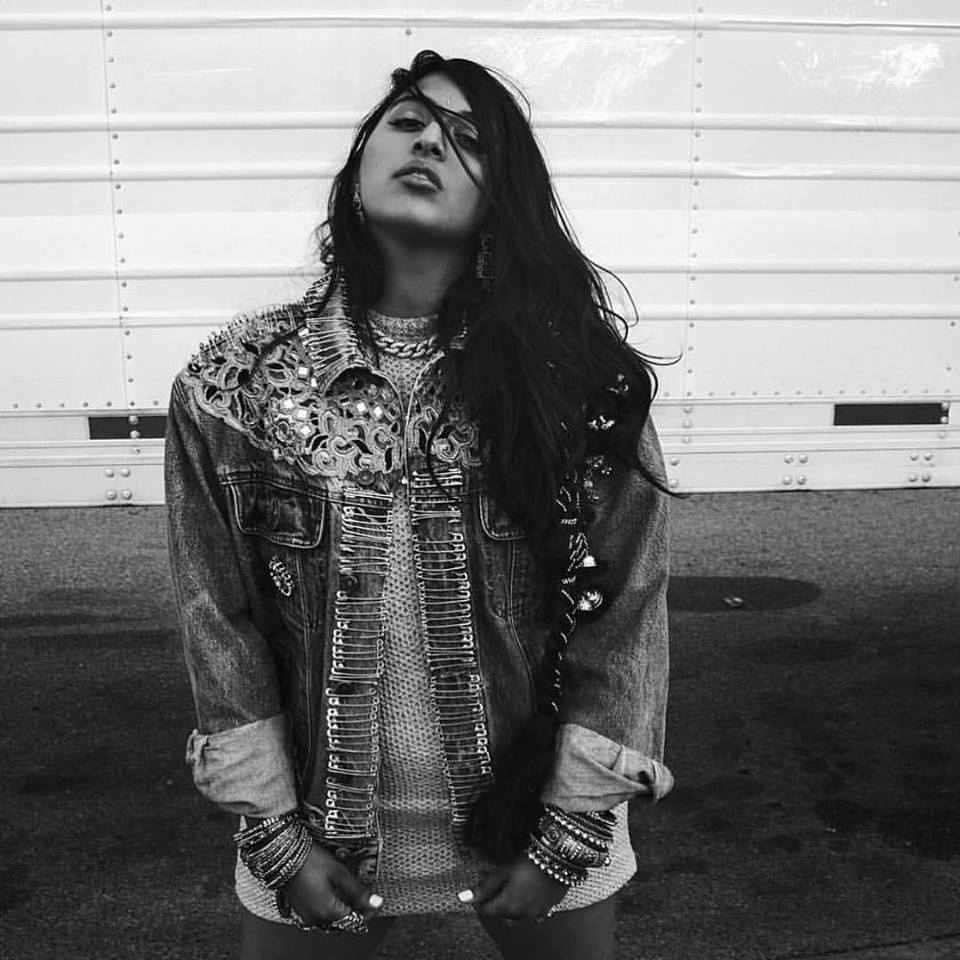
PUNK STREET
Bringing this trend to the streets of India are young lasses like Roshini Kumar, Komal Pandey, Prabhleen, Aanchal Sukhija and many more. The Amazon India Fashion Week saw many of them walk down the streets flaunting the creative mix of punk and Indian silhouettes!
The brightly dyed hair, multiple nose or ear piercings, bindis, dark lips, rage in the eyes and the bold confidence of being comfortable in their own skin seemed like a fresh shift from the idea of worshiping Bollywood-manufactured trends.
” Many things about Indian fashion have been underrated” says Roshini Kumar, fashion photographer based in Bangalore.
Commenting on her eclectic style which is a harmonious blend of bindi with quirky hair and multiple piercings, Roshini says how perfectly all these elements signify her. Fashion to her is not about following trends but a medium of self-expression. Punk is as much part of it as are her bindis and jhumkas. So does the desi blingy-ness complement the dark edginess of punk? To this the Roshini was happy to add that “I think any two fashion trends and go with each other, it depends on how you make the mix and how you pull it off” and she certainly is acing at it.
Komal Pandey, a Delhi-based fashion blogger also loves amalgamating styles and a rebellious Indian look with a fusion of indo-western elements is definitely her forte. Aanchal Sukhija whose jewelry designed using everyday mundane objects and trash like pipes, steel scrubs, AC foam, and mops was showcased at New York Fashion Week earlier this year. Her personal style is also equally dramatic and unique! The DIY approach towards of curating something will the traditional-ness intact with an unexpected element is what makes her a different kind of Indian-ly punk women.
Conclusions can be complex and complicated! But Indian punk or punk in India is not about the evolution of Desi Sex Pistols ( as scandalous as it sounds) or about Shah Rukh Khan wearing a black embroidered kurta with skinny leather pants in Bollywood movie, Main Hoon Na. It is out there as a major street style trend waiting to become bigger and is about these women choosing to ignore nasty comments and shunning stereotypes expecting them to dress up “modestly”.
Un-imagine tequilla, tacos and even the teeming towns.
Shedding away its stereotypical image and proudly embracing its cultural richness and exclusivity, Mexico is emerging as the new centre of creativity. Brimming with talented works of art by young artists and designers who are finally grabbing the spotlight in the last few years, this North American country is one to watch out for.
Seeing the Mercedes Benz Fashion Week Mexico City 2017 which kicked off on November 12 as an opportunistic platform, Mexican illustrator and journalist, Talia Castellanos is another artist who attempted to bring the country on the forefront of fashion and art. Her #drawlatinfashionmx campaign on Instagram has received an overwhelming response from the creative community worldwide.
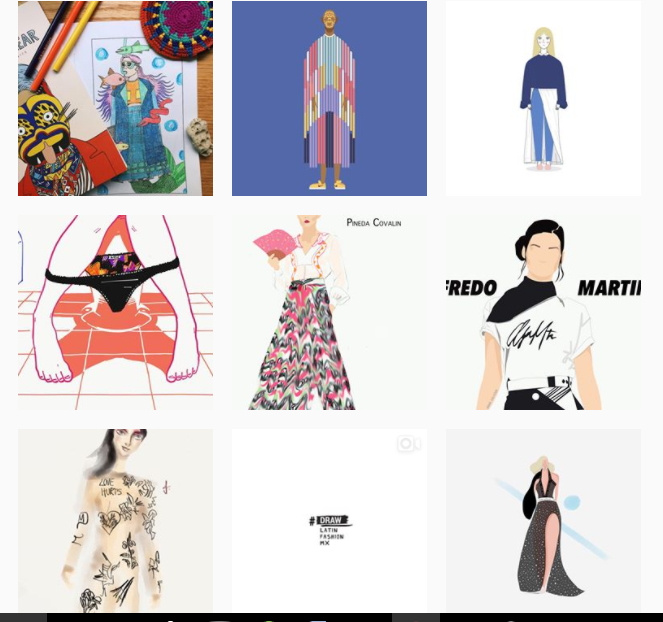
Talia who is now based in Amsterdam and has spent few months studying fashion in London feels quite strongly about this shift of young designers moving back to their roots for inspiration and creating something contemporary.
Adding to this, London’s V & A Museum is bringing something very Mexican for its audience coming summer, Frida Kahlo’s Wardrobe; a fashion exhibition that will give insight into the private life of the cult figure who was equally known for her flamboyant style as for her paintings. First time in Europe, one can get to see her wardrobe and personal belongings on display which were very much symbolic of the traditional Mexican style juxtaposed beautifully with western heritage.
Tickets available soon! https://www.vam.ac.uk/exhibitions/frida-kahlos-wardrobe
A LEGACY UNVEILED
Not so long ago Demna Gsavalia left us awestruck with his tributary couture pieces that concluded his A/W 2017 collection for Balenciaga. Could there have been a better way to honour the legendary couturier for the house’s centenary year? Balenciaga: Shaping Fashion, the much-awaited fashion exhibit at London’s V&A Museum did seem to answer that.
An extravagant display of over 100 pieces of the designer, his protégées and contemporary fashion designers whom he has inspired is spread across two levels of the fashion gallery 40. With garments mostly dating back to the 1950s and the 1960s, when the designer was at the peak of his career, you see more than just numerous dress-stands decked up in elaborate evening gowns and pretty-looking dresses. You get to know who exactly Balenciaga’s woman was (she definitely preferred less of those seams and more of the drama around her sleeves). And he, who was practising couture in the actual sense, knew how to make this woman feel powerfully elegant even in the most non-traditional silhouettes (the sack dress is just one of the examples!) and the most unconventional textiles and cuts (Think feathers and balloon hems). Cristobal Balenciaga was after all who he was, “The Master of us all”.